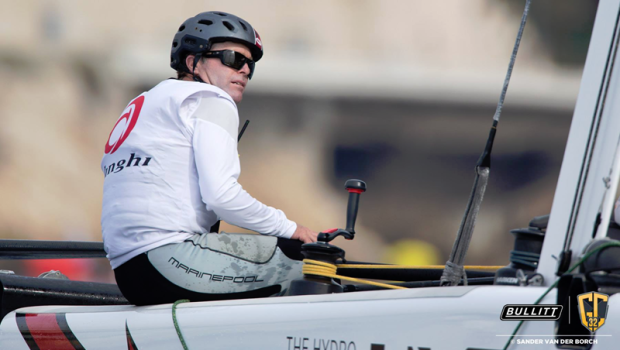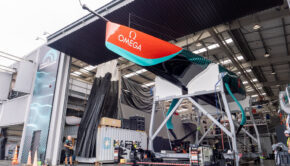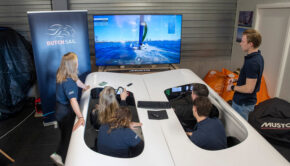Morgan Larson: Ahead of his time
Published on November 11th, 2015
When the America’s Cup format was changed for the 2013 edition, it was following the lead by the well-established Extreme Sailing Series (ESS). Launched in 2007, the ESS was an annual global racing series, it was a sustainable commercial model, and was raced in Extreme 40 catamarans in stadium-type settings. Sound familiar?
With the America’s Cup focus on high performance boats, and high performance sailors, American Morgan Larson figured his phone would ring. As a 3-time podium finisher at the 49er Worlds, and 505 World Champion, Larson also claimed top three finishes at the Melges 32, Farr 40, and TP 52 Worlds.
But when a suitable offer for the America’s Cup was not presented, he has focused his talents on what the America’s Cup has copied, and to no surprise, he’s excelled there too.
After winning the 2014 Extreme Sailing Series, the Alinghi team led by skipper American Morgan Larson tried their hand at the 2015 GC32 Racing Tour. The close course format was similar, but Larson was moving from the older non-foiling Extreme 40 to the newly designed foiling GC32 catamaran. Sharing helm duties with team owner Ernesto Berterelli, the team finished a close second.
Scuttlebutt editor Craig Leweck checked in with the 44-year old Larson on racing the foiling catamaran.
What was the transition like adjusting to GC32 after having raced the Extreme 40?
The GC is a pretty different beast! All the same principles until the wind is above 8-10 knots and then you take flight. Unlike the wing-masted AC 45s, we don’t foil upwind unless it is really windy and you need a fast forward mode. Downwind you’re foiling from 8-10 knots and on. We are pretty similar in performance VMG to the AC 45s downwind. Compared to the Extreme 40s, there is way more going on in terms of boat handling due to the management of the front foils.
How does foiling affect strategy or tactics?
The speeds increase and the angles decrease. Strangely, there seems to be more of an advantage downwind to be in front than behind. The dirty air and turbulent water your sails and foils produce really makes it hard for a trailing boat to gain. As a whole, tactics become more critical as maneuvers are costly; you can’t just change your mind and tack or gybe back the other way so easily as you can on a traditional boat.
When not foiling, does the GC32 feel sluggish due to the large foils?
For sure there is some drag associated with the L foils plus the boats are set up with less sail area. The gennakers are flatter than the Extreme 40s so you’re able to carry them upwind until about 7 knots TWS which really helps.
The Extreme Sailing Series will use the GC32 in 2016. Will there need to be any adjustments to the format due to the speed or handling of the GC32?
This is a big question that largely can’t be answered until we try out the small course format. I think you will find out that physically it will burn up people. Having to maneuver so much in a tight arena will be a challenge for the crews. You can’t imagine the amount of energy it takes to lift and drop the foils.
In the Extreme Sailing Series format, you will be likely just finishing a board movement and then you will hear “gybing”! The teams will really need athletes to get through an eight race day. It is a significant difference compared to the AC World Series where you have courses 4-times as long and only a two race day!
Is there a practical limit as to how many GC32s could race at one time? Certainly course size is a factor, but even on a large course, are there aspects of the racing that might get too hairy in big fleets?
For sure this will be an issue. It was with the Extreme 40s, and there were venues that when it was really windy and shifty, we had to split the fleets. I am sure this will happen again.
Given your success in the ESS and GC32, is a transition into the America’s Cup in the cards?
I’d imagine age may be the deciding factor although I feel very comfortable in the boat still. I was offered a job skippering one of the teams but the pay scale for the amount of commitment wasn’t where it needed to be for me personally.
Quality sailing with the right people is what my objective is now. I’ve really tried to limit my sailing days away from home to be under 100 per year which is a challenge with all the great sailing out there.
I’m a big fan of the technology and platform they are using in the America’s Cup so hopefully they can create a format that is good for the sport as a whole.









 We’ll keep your information safe.
We’ll keep your information safe.